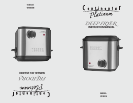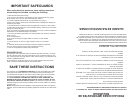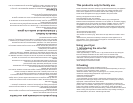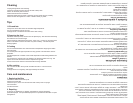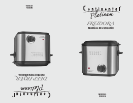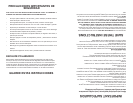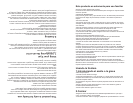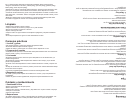Cleaning
•Unplug the appliance when cleaning.
•Clean the outside of the fryer and the lid with a damp cloth.
•Never use abrasive pads or alcohol.
•Detach the handle from the basket.
•Wash the basket with hot water or washing-up liquid. Rinse and dry carefully.
•Never immerse the appliance in water or wash it directly by water.
Tips
1.Oils and fats
•Always use oil and fats which can withstand high temperature.
•Do not mix different types of oil or fat.
•Change the oil or fat when it becomes brown after cooking.
2.Preparing the food
•Whatevertherecipeused,thefoodmustbeperfectlydry:thiswillavoidoverowing
and make the oil or fat last longer.
•When preparing potato-based food (chips, crisps, etc.), cut them up and then wash
them in cold water to remove the starch. Dry them carefully. This will stop them
sticking together.
3.Cooking
•Donotoverllthebasket.Thiswillcausetheoiltemperaturedroppingandmake
the food greasy.
•Do not keep the oil at high temperature for long periods. This will make it lose its
properties.
•Set the temperature controller to the lowest temperature while waiting between two
batches.
•Do not leave the cooked food in the basket in the draining position too long. The
vapors could cause the food to lose its crispness and go soft.
•Frozen food can be cooked in the basket without being defrosted.
4.After cooking
•Oil or fat can be left in the fryer with its basket and lid on. It will not lose its
properties.
•Change the fat or oil regularly, after approximately 20 batches.
Care and maintenance
1. Replacing the lter
• Detach the fence lid from the top lid.
•Removetheusedlter.
•Clean the top lid, inner cover and fence lid with a damp cloth or sponge.
•Setanewlter.
•Set fence lid back.
2. Repairing:
•If there is any breakdown or damage, the appliance must be repaired by
specialized people. Non-specialized people are not permitted to dismantle or repair
the appliance.
tos), la freidora habrá alcanzado la temperatura deseada. Quite la tapa superior.
•Ponga la comida dentro del cesto, patatas (250g), pescado (250g), gambas (200g),
bistec (250g), muslo de pollo (300g).
•Descender el cesto en el aceite de manera despacio, observe el nivel del aceite y ase-
gure que no sobrepase el nivel máximo de la freidora, cierre después con la tapa.
•Cuando la comida esté hecha, gire el control de temperatura en sentido contrario al de
reloj hasta “OFF”, el indicador “HEAT” se apagará. Abra la tapa, levante el cesto y escur-
rie el aceite.
•Mientras la freidora está en funcionamiento, el control de temperatura puede estar
encendido o apagado de acuerdo con la temperatura del aceite.
Limpieza
•Desenchufe el aparato cuando lo limpie.
•Limpie el exterior de la freidora y la tapa con un paño húmedo.
•Nunca use productos corrosivos ni alcohol.
•Separe el mango del cesto.
•Limpie el cesto con agua caliente o lavavajillas. Enjuáguelos y séquelos cuidadosa-
mente.
•No sumerja el aparato en agua ni lo lave directamente con ella.
Consejos prácticos
1. Aceites y grasas
•Use siempre aceites y grasas que resistan temperaturas altas.
•No mezcle diferentes tipos de aceite o grasa.
•Cambie el aceite o grasa cuando se vuelvan marrón después de su uso.
2. Preparando la comida
•Cualquiera receta que sea, la comida debe estar perfectamente seca: esto evitará der-
ramar el aceite o grasa y los hará durar más.
3. Cocinando
•No llene en exceso el cesto. Eso hará que la temperatura no sea el adecuado y la
comida esté grasienta.
•No mantenga el aceite a altas temperaturas durante mucho tiempo, ya que le hará
perder sus propiedades.
•Ajuste el control de temperatura al mínimo mientras acaba una comida y empiece con
otra.
•No deje la comida frita en el cesto en posición para escurrir durante demasiado tiempo.
Eso le hará menos crujiente.
•La comida congelada puede freirse en el cesto sin descongelarse antes.
4.Después de cocinar
•El aceite o grasa pueden dejarse en la freidora con el cesto y tapa. No perderá sus
propiedades.
•Cambie la grasa o aceite regularmente, después de aproximadamente 20 usos.
Cuidado y mantenimiento
1.Cambiando el ltro
•Separe la tapa lateral de la tapa superior.
•Quiteelltrousado.
•Limpie la tapa superior, cubierta interior y tapa lateral con un paño húmedo o esponja.
•Coloqueunnuevoltro.
•Coloque la tapa lateral.
2.Reparaciones
•Si hubiera algúna rotura o daño, el aparato debe ser reparado por especialistas. Las
personas no especialistas no están permitidas desmontar o reparar el aparato.



